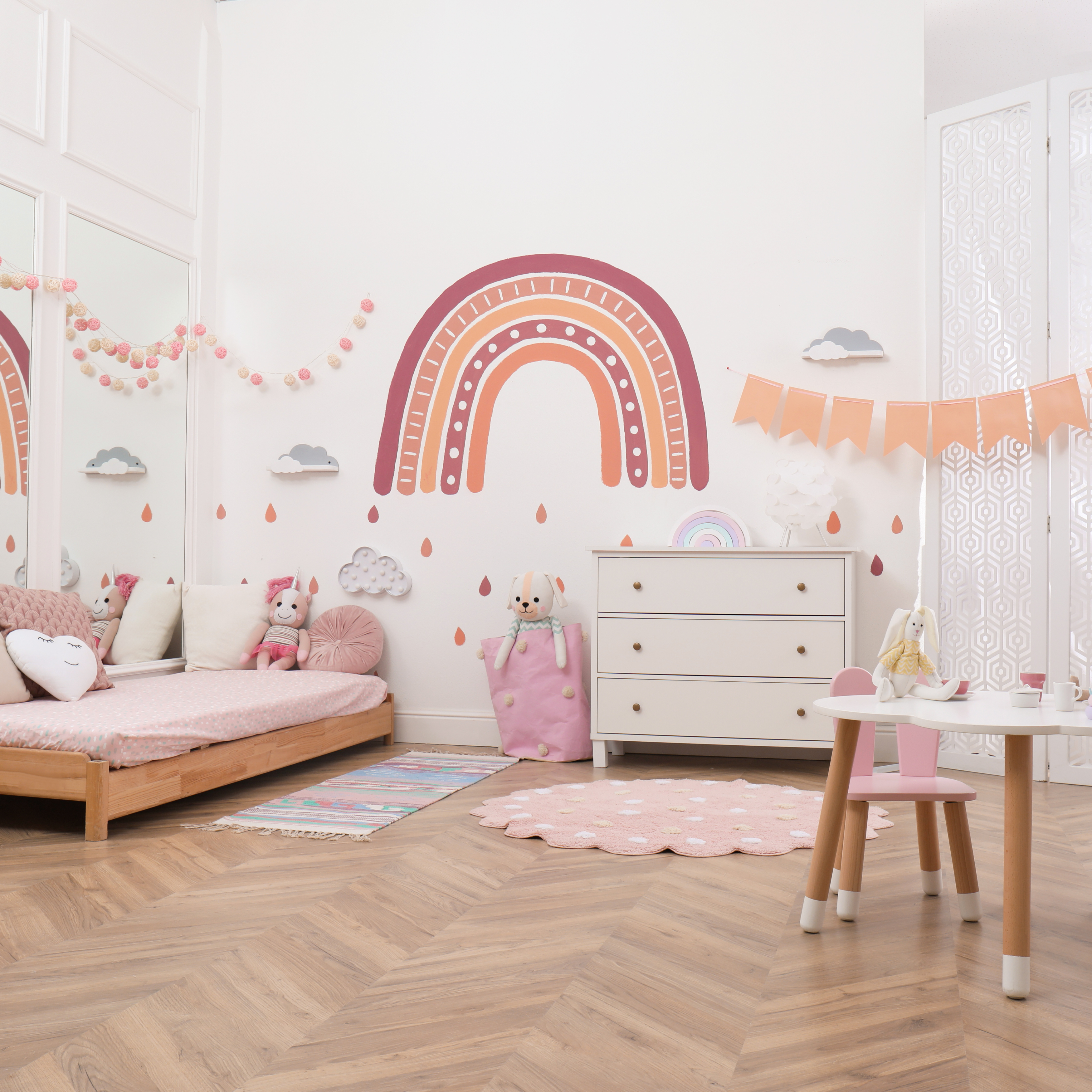Creating a Montessori-inspired bedroom is not just about design; it’s a philosophy that fosters independence, creativity, and a sense of ownership for your little one. In this guide, we’ll explore the key elements that make a Montessori bedroom, the ideal age for a Montessori bed, and how to curate a space that reflects the essence of Montessori education.
What Makes a Montessori Bedroom?
A Montessori bedroom is more than just a room; it’s a carefully curated environment designed to empower children. The principles of a Montessori bedroom include fostering independence, providing easy access to toys and activities, and incorporating natural and simple elements. One key element that can truly elevate your Montessori space is the choice of decor.
Crafty Curations’ Round Rainbow Rug is a stellar example of Montessori-inspired decor. Its rich rainbow design adds a splash of color to the room, stimulating creativity and joy. Crafted with meticulous attention to detail, this personalized rug is more than just a floor covering; it’s a statement piece that aligns perfectly with the principles of a Montessori bedroom.
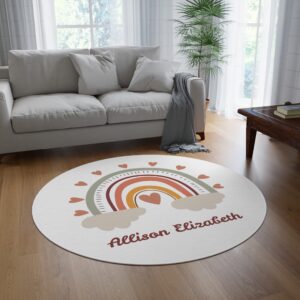
What Age is Appropriate for a Montessori Bed?
Two of the most asked questions I get asked about setting up a Montessori bedroom is “how safe is a Montessori floor bed, & what age is appropriate to use a floor bed?” Typically, the ideal age for a Montessori bed is around 18 months to 3 years. The low height of the bed allows for easy entry and exit, encouraging independence and a sense of freedom for your little one.
Montessori beds are designed to provide a safe and accessible sleeping space for toddlers transitioning from a crib. Some people who practice the method will use a floor bed from the infant stage, but I’ve never felt comfortable with that, and since I haven’t done it myself, I won’t give advice on that.
When setting up a Montessori bed, consider the transition as a significant milestone for your child. It’s not just about moving from a crib to a bed; it’s a step towards autonomy and self-reliance.
The 2 Shelf Double-Sided Shelves mentioned in a previous blog post are an excellent addition to the Montessori bed transition. These shelves, available on Amazon, offer a practical storage solution for bedtime essentials, books, and other items. If you missed our previous post on creating a cozy reading nook, check it out here.
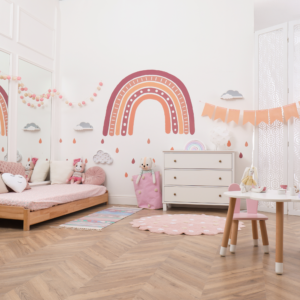
How to Set Up a Montessori Bedroom
- Choose Low Furniture: Embrace the Montessori philosophy by opting for low-profile furniture. Low bookshelves, child-sized tables, along with the Montessori floor bed contribute to an environment where everything is within reach for your child.
- Personalize with a Round Rainbow Rug: Elevate the aesthetic of the room with a personalized touch. The Round Rainbow Rug from my Etsy shop will not only add color and vibrancy but also allows you to include your child’s name, making the space uniquely theirs.
- Introduce Montessori Playroom Decor: Extend the Montessori theme with carefully chosen decor items. Consider incorporating the Montessori Playroom Decor collection from Crafty Curations, designed to stimulate creativity and imagination.
- Botanical Wall Art for a Nature-Inspired Space: Bring the outdoors in with Botanical Wall Art. Nature-themed decor aligns well with Montessori principles, fostering a connection with the natural world.
- Include Comfortable Seating: Create cozy nooks with child-sized seating. Soft cushions, bean bags, or small chairs provide comfortable spots for reading, play, and relaxation.
- Encourage Independence with the Montessori Bookshelf: The Montessori Bookshelf serves as a focal point for fostering a love of reading. Display books at your child’s eye level, encouraging them to explore and choose their own reads independently.
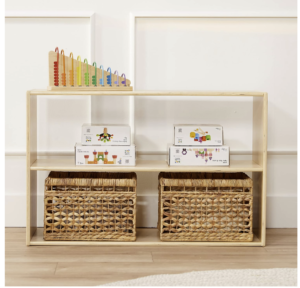
Tips for Maintaining a Montessori Bedroom
Creating a Montessori-inspired bedroom is just the beginning; maintaining the space is equally important to ensure it continues to nurture your child’s development. Here are some tips for keeping the Montessori magic alive:
- Rotate Toys and Activities: Keep the environment fresh and engaging by regularly rotating toys and activities. This prevents boredom and encourages exploration and creativity.
- Foster a Sense of Order: Montessori philosophy emphasizes order and organization. Teach your child to clean up after themselves and instill a sense of responsibility for their space. This will take A LOT of repetition, but will pay off, trust me.
- Adapt as Your Child Grows: As your child develops new skills and interests, adapt the Montessori bedroom accordingly. Consider updating decor, furniture, and activities to align with their evolving needs.
- Encourage Exploration: A Montessori bedroom is a place for discovery. Create opportunities for your child to explore and learn independently. Incorporate elements like the 2 Shelf Double-Sided Shelves mentioned in a previous blog post for a versatile storage solution.
- Celebrate Personal Achievements: Acknowledge and celebrate your child’s milestones and achievements within their Montessori bedroom. This reinforces a positive connection with their space and encourages a sense of pride and accomplishment.
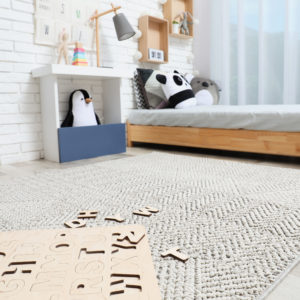
Crafting a Montessori Oasis for Lifelong Learning
Crafting a Montessori-inspired bedroom is a thoughtful journey that goes beyond aesthetics. It’s about fostering a nurturing environment that supports your child’s growth and development. From the choice of a personalized Round Rainbow Rug to the incorporation of Montessori decor, every element contributes to a space that resonates with the principles of Montessori education.
Whether your child is making the transition to a Montessori bed or you’re revamping their existing space, these tips and recommendations aim to guide you in creating a room that reflects the elegance and independence inherent in the Montessori philosophy.
Curate a space where curiosity thrives, creativity blossoms, and your child feels a true sense of ownership. Your Montessori-inspired bedroom is not just a room; it’s a canvas for growth, exploration, and the joy of learning.
Let me know if there are any steps in the process you want more information about, or any questions you have in the comments. I’ll be answering them every day!

